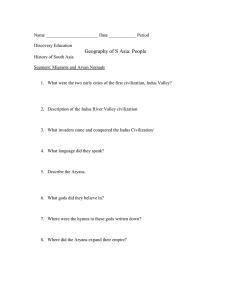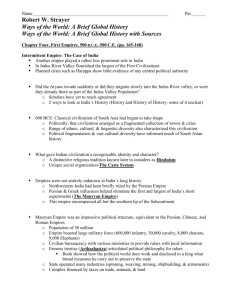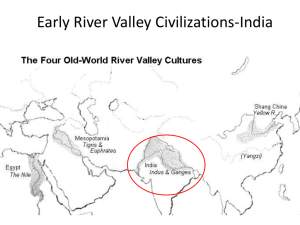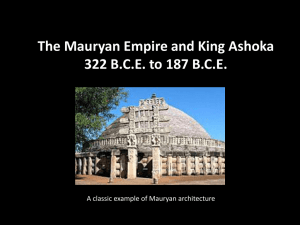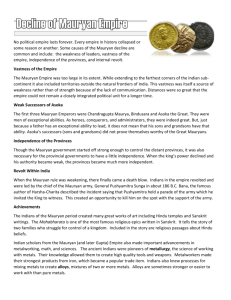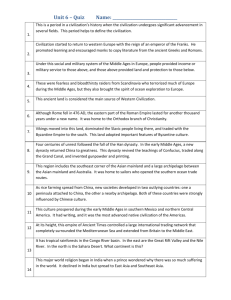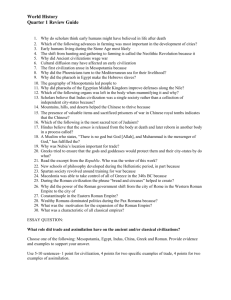Intermittent Empire: The Case of India
advertisement
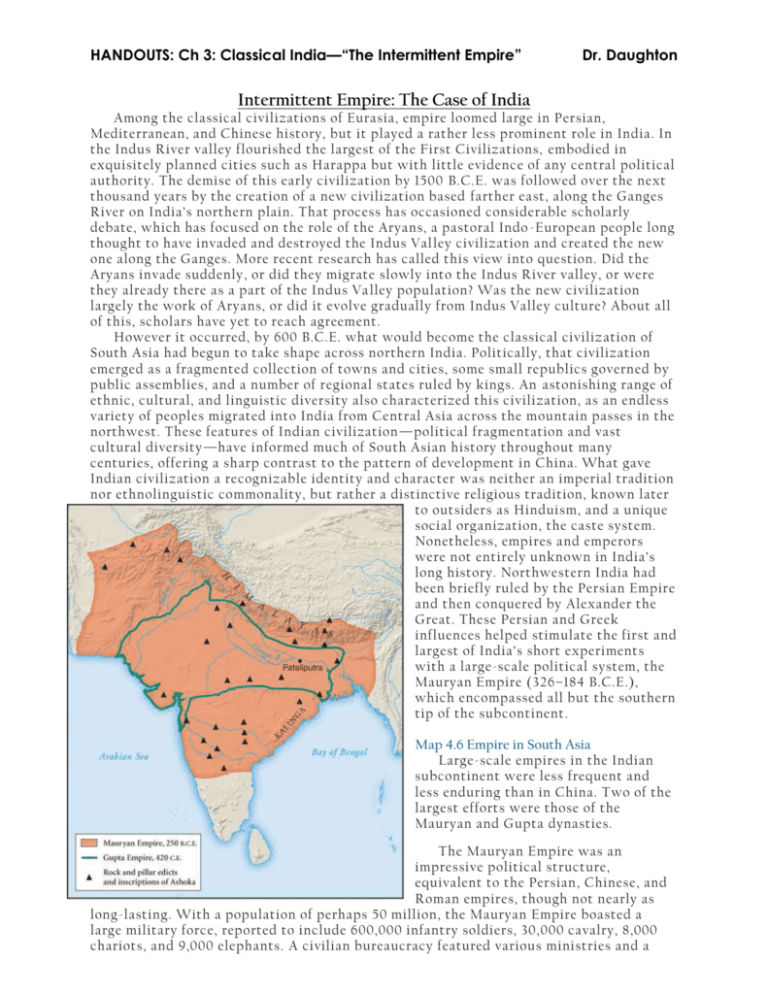
HANDOUTS: Ch 3: Classical India—“The Intermittent Empire” Dr. Daughton Intermittent Empire: The Case of India Among the classical civilizations of Eurasia, empire loomed large in Persian, Mediterranean, and Chinese history, but it played a rather less prominent role in India. In the Indus River valley flourished the largest of the First Civilizations, embodied in exquisitely planned cities such as Harappa but with little evidence of any central political authority. The demise of this early civilization by 1500 B.C.E. was followed over the next thousand years by the creation of a new civilization based farther east, along the Ganges River on India’s northern plain. That process has occasioned considerable scholarly debate, which has focused on the role of the Aryans, a pastoral Indo -European people long thought to have invaded and destroyed the Indus Val ley civilization and created the new one along the Ganges. More recent research has called this view into question. Did the Aryans invade suddenly, or did they migrate slowly into the Indus River valley, or were they already there as a part of the Indus Va lley population? Was the new civilization largely the work of Aryans, or did it evolve gradually from Indus Valley culture? About all of this, scholars have yet to reach agreement. However it occurred, by 600 B.C.E. what would become the classical civiliz ation of South Asia had begun to take shape across northern India. Politically, that civilization emerged as a fragmented collection of towns and cities, some small republics governed by public assemblies, and a number of regional states ruled by kings. An astonishing range of ethnic, cultural, and linguistic diversity also characterized this civilization, as an endless variety of peoples migrated into India from Central Asia across the mountain passes in the northwest. These features of Indian civilization —political fragmentation and vast cultural diversity—have informed much of South Asian history throughout many centuries, offering a sharp contrast to the pattern of development in China. What gave Indian civilization a recognizable identity and character was neither an imperial tradition nor ethnolinguistic commonality, but rather a distinctive religious tradition, known later to outsiders as Hinduism, and a unique social organization, the caste system. Nonetheless, empires and emperors were not entirely unknown in India’s long history. Northwestern India had been briefly ruled by the Persian Empire and then conquered by Alexander the Great. These Persian and Greek influences helped stimulate the first and largest of India’s short experiments with a large-scale political system, the Mauryan Empire (326–184 B.C.E.), which encompassed all but the southern tip of the subcontinent. Map 4.6 Empire in South Asia Large-scale empires in the Indian subcontinent were less frequent and less enduring than in China. Two of the largest efforts were those of the Mauryan and Gupta dynasties. The Mauryan Empire was an impressive political structure, equivalent to the Persian, Chinese, and Roman empires, though not nearly as long-lasting. With a population of perhaps 50 million, the Mauryan Empire boasted a large military force, reported to include 600,000 infantry soldiers, 30,000 cavalry, 8,000 chariots, and 9,000 elephants. A civilian bureaucracy featured various ministries and a HANDOUTS: Ch 3: Classical India—“The Intermittent Empire” Dr. Daughton large contingent of spies to provide the rulers with local information. A famous treatise called the Arthashastra (The Science of Worldly Wealth ) articulated a pragmatic, even amoral, political philosophy for Mauryan rulers. It was, according to one scholar, a book that showed “how the political world does work and not very often stating how it ought to work, a book that frequently discloses to a king what calculating and sometimes brutal measures he must carry out to preserve the state and the common good.” 1 3 The state also operated many industries—spinning, weaving, mining, shipbuilding, and armaments. This complex apparatus was financed by taxes on trade, on herds of animals, and especially on land, from which the monarch claimed a quarter or more of the cro p. 1 4 Ashoka of India This twelfth-century stone relief provides a visual image of the Mauryan dynasty’s best -known ruler. Mauryan India is perhaps best known for one of its emperors, Ashoka (reigned 268–232 B.C.E.), who left a record of his activities and his thinking in a series of edicts carved on rocks and pillars throughout the kingdom. Ashoka’s conversion to Buddhism and his moralistic approach to governance gave his reign a different tone than that of China’s Shihuangdi or of Alexander the Great, who, according to legend, wept because he had no more worlds to conquer. His legacy to modern India has been that of an enlightened ruler, who sought to govern in accord with the religious values and moral teachings of Hinduism and Buddhism. Despite their good intentions, these policies did not long preserve the empire, which broke apart soon after Ashoka’s death. Several other short-lived imperial experiments, such as the Gupta Empire (320 –550 C.E.), also marked India’s history, but none lasted long. India’s political history thus resembled that of Western Europe after the collapse of the Roman Empire f ar more than that of China or Persia. Neither imperial nor regional states commanded the kind of loyalty or exercised the degree of influence that they did in other classical civilizations. India’s unparalleled cultural diversity surely was one reason, as was the frequency of invasions from Central Asia, which repeatedly smashed states that might have provided the nucleus for an all -India empire. Finally, India’s social structure, embodied in a caste system linked to occupational groups, made for intensely local loyalties at the expense of wider identities. Nonetheless, a frequently vibrant economy fostered a lively internal commerce and made India the focal point of an extensive network of trade in the Indian Ocean basin. In particular, its cotton textile industry long supplied cloth throughout the Afro -Eurasian world. Strong guilds of merchants and artisans provided political leadership in major towns and cities, and their wealth patronized lavish temples, public buildings, and religious festivals. Great creativity in religious matters generated Hindu and Buddhist traditions that later penetrated much of Asia. Indian mathematics and science, especially astronomy, also were impressive; Indian scientists plotted the movements of stars and planets and recognized quite early that the earth was round. Clearly, the absence of consistent imperial unity did not prevent the evolution of an enduring civilization. Comparison Why were centralized empires so much less prominent in India than in China?
